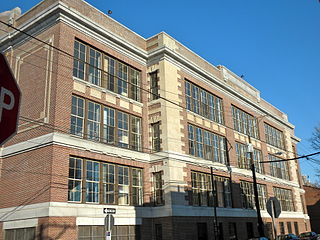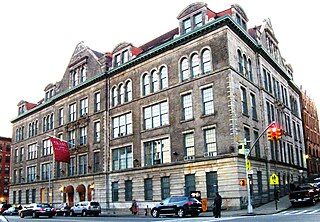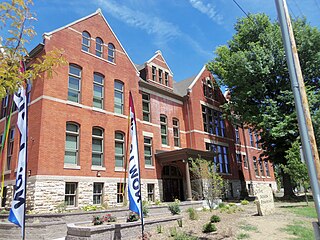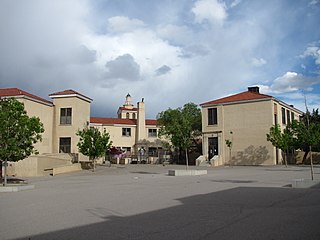
Queen Anne is a neighborhood and geographic feature in Seattle, Washington, United States, located northwest of downtown. The affluent neighborhood sits on the eponymous hill, whose maximum elevation is 456 feet (139 m), making it Seattle's highest named hill. Queen Anne covers an area of 7.3 square kilometers (2.8 sq mi), and has a population of about 28,000. It is bordered by Belltown to the south, Lake Union to the east, the Lake Washington Ship Canal to the north and Interbay to the west.

Inman Park is an intown neighborhood on the east side of Atlanta, Georgia, and its first planned suburb. It was named for Samuel M. Inman.

Queen Anne High School (1909–1981) was a Seattle Public Schools high school on Galer Street atop Queen Anne Hill in Seattle, Washington, United States. The building was converted to condominium apartments in 2007.

Fairlington is an unincorporated neighborhood in Arlington County, Virginia, United States, located adjacent to Shirlington in the southernmost part of the county on the boundary with the City of Alexandria. The main thoroughfares are Interstate 395 which divides the neighborhood into North and South Fairlington, State Route 7 and State Route 402.

Hawthorne is a neighborhood in the South Philadelphia section of Philadelphia, Pennsylvania, United States. It is located between Broad Street and 11th Street, and extends from South Street to Washington Avenue.

Bedford School, located at 910 Bingham Street in the historic South Side Flats neighborhood of Pittsburgh, Pennsylvania, has been listed in the National Register of Historic Places since 1986. According to Pittsburgh History and Landmarks Foundation, it is the oldest public school building still standing within the city of Pittsburgh.

The Mount Royal Station is a historic building in Baltimore, Maryland, which was the Baltimore and Ohio Railroad's third train station in Baltimore, Maryland, and is now part of the Maryland Institute College of Art (MICA) campus. The station was at the north end of the Baltimore Belt Line's Howard Street tunnel in the Bolton Hill neighborhood. It was the first railroad station in the world to have electrified passenger trains when it opened on September 1, 1896, serving the B&O's famed Royal Blue line. Following its closure as a railroad station in 1961, it became part of the Maryland Institute College of Art, where it now houses the Middendorf Gallery, as well as studio and classroom space for the university's sculpture and fiber departments.

Queen Anne Boulevard is a 6.0-kilometre (3.7 mi) loop atop Seattle, Washington's Queen Anne Hill. It is a City of Seattle landmark. Authorized in 1907 and built from 1911 to 1916, it incorporates parts of 5th, 7th, 8th and 10th Avenues West; Bigelow Avenue North; West Blaine, McGraw, Wheeler, Fulton and Raye Streets; Smith, McGraw, and Wheeler Streets; West Highland Drive; and West McGraw and McGraw Places.

The Bunker Hill School is a historic school at 68 Baldwin Street in the Charlestown neighborhood of Boston, Massachusetts. Built in 1866, it is a prominent local example of Second Empire architecture, and a surviving example of the city's school planning in the post-Civil War period. Now housing residential condominiums, it was listed on the National Register of Historic Places in 1987.

The Bloomingdale School is a historic former school building at 327 Plantation Street in Worcester, Massachusetts. Built in 1896, it is a notable local example of Richardsonian Romanesque architecture. It was used as a school until 1982, after which it was converted into residences. The building was listed on the National Register of Historic Places in 1980.

P.S. 157 is a historic school building located at 327 St. Nicholas Avenue between West 126th and West 127th Streets in the Harlem neighborhood of Manhattan, New York City. It was built from 1896 to 1899 and was designed by C. B. J. Snyder in the Renaissance Revival style. It ceased being a school in 1975, and was converted to rental apartments in 1993.

Buchanan School, also known as The Naval Station, is a historic building located in the West End of Davenport, Iowa, United States. It was listed on the National Register of Historic Places in 1983. Since 2019 the building has housed a senior living apartment building.

School Number 6, also known as Jackson School and Holy Family School, is an historic building located in Davenport, Iowa, United States. It was listed on the Davenport Register of Historic Properties and on the National Register of Historic Places in 2011.

The Janney Elementary School is a public elementary school from Pre-K through 5th grade. A part of the District of Columbia Public Schools, it enrolls approximately 740 students.

Charles S. Foos Elementary School, also known as Douglass and Weiser School, is a historic elementary school building located at Reading, Berks County, Pennsylvania. It was built in 1903 and was expanded and renovated in 1912. A small addition was built in 1921. It was originally in the Romanesque Revival style, but transformed to the Classical Revival style with the renovations. The "C"-shaped brick building contains 21 classrooms and an auditorium that seats over 200. The school closed in 1979. Part of the very large school building is now a nursery school, and part condominiums.

Monte Vista Elementary School is a public elementary school in the Nob Hill neighborhood of Albuquerque, New Mexico, whose campus is listed in the New Mexico State Register of Cultural Properties and the National Register of Historic Places. It is notable as one of the city's best examples of Mediterranean Revival architecture and as the historical focal point of the surrounding neighborhood. It is a part of Albuquerque Public Schools.

The architecture of Seattle, Washington, the largest city in the Pacific Northwest region of the U.S., features elements that predate the arrival of the area's first settlers of European ancestry in the mid-19th century, and has reflected and influenced numerous architectural styles over time. As of the early 21st century, a major construction boom continues to redefine the city's downtown area as well as neighborhoods such as Capitol Hill, Ballard and, perhaps most dramatically, South Lake Union.

West San Jose School, also known as Riverview School, is a historic former elementary school in the Barelas neighborhood of Albuquerque, New Mexico. It was built in 1936–37 as a Works Progress Administration project and operated as a school until 1975. It is now part of the National Hispanic Cultural Center. The building was added to the New Mexico State Register of Cultural Properties and the National Register of Historic Places in 1996.

The Old Winona Middle School is a former school complex in Winona, Minnesota, United States. The east building was originally constructed as the Winona High School from 1915 to 1917 and the west building was added as the Winona Junior High School in 1926. An auditorium was added to the rear of the east building in 1928. In 1988 the complex became the Winona Middle School. The property was listed on the National Register of Historic Places as the Winona High School and Winona Junior High School in 2004 for its local significance in the theme of education. It was nominated for representing local efforts to implement progressive educational trends in updated facilities, while offering cultural experiences to the wider community through professional music performances in the auditorium.





















